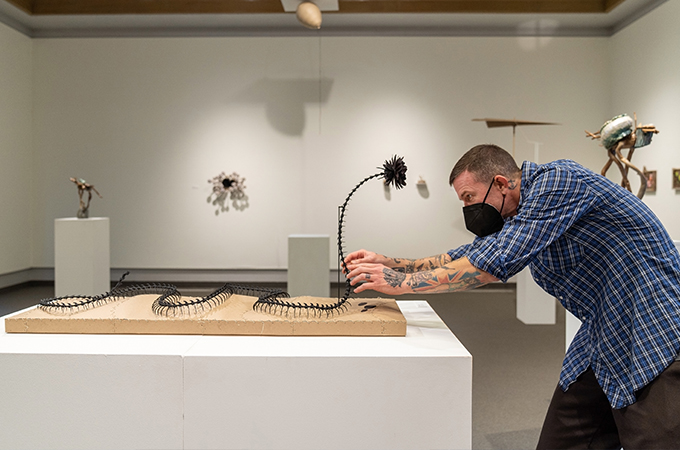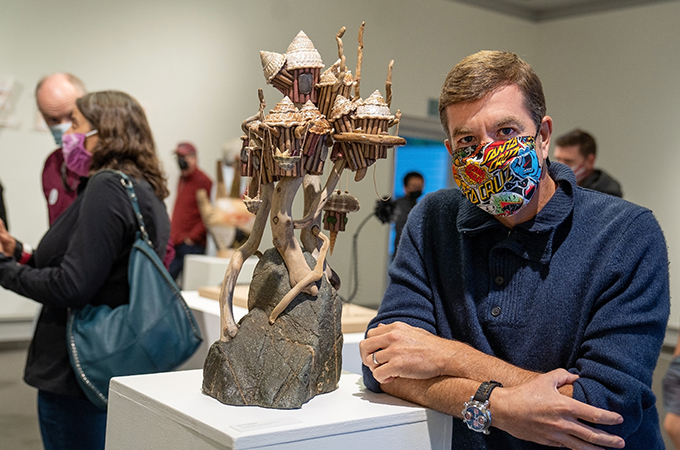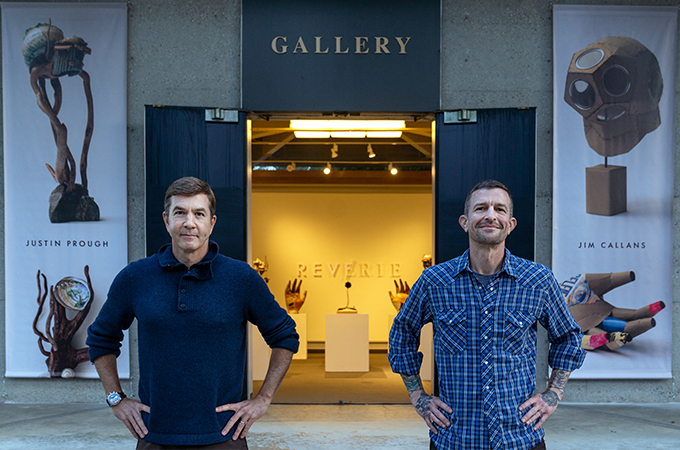The title of the latest art show in the University of Redlands Gallery is Reverie, harkening to the state of being pleasantly lost in one’s thoughts. The two artists featured in the exhibit, Jim Callans ’96 and Justin Prough ’95, say that each piece was inspired by the dream worlds they occupy—places they both retreated to during the COVID-19 pandemic. As a result, viewers are filled with a sense of whimsy and otherworldliness as they experience the show.
Callans and Prough, who met at Redlands and have been friends since graduating with degrees in studio art, approached the department about creating a show before the pandemic. “Because the two artists are alumni of our program, we’ve kept in touch with them over the years,” said Art Department Chair and Professor Penny McElroy. “They submitted a portfolio for review which was approved by the department. As we return to hosting Gallery shows, we thought it would be nice to schedule this one to open around Homecoming Weekend.”
To mark the show’s opening, the department hosted two receptions—one on October 20 and another on October 23, during Homecoming festivities. Each featured live music, hors d’oeuvres, and informal artist talks.
The art of awe
During the talks, Callans and Prough discussed their creative processes, materials, and the meaning behind the pieces they make. While Callans’ works explore the possibilities of materials and mediums, Prough scavenges coastlines for seashore debris, constructing fantastical oceanic sculptures and paintings.
“As we went along and thought about this show, we realized there were definite thematic ties with our work,” said Callans. “There was a tie-in with materials. Justin is finding these fascinating materials that he found and put together in unique ways, and I'm using a very basic material, trying to push the limits of cardboard, to create things that haven't necessarily been seen before. But both bring about the mysterious and the dream world—that blurry line between what's real and what's not. I want there to be a little bit of mystery; I want people to wonder.”

Callans, who grew up in California and Hawaii, is an art director and designer who owns a vintage letterpress and design studio in Venice, California. For Reverie, he married sculpture, photography, and architecture using parametric design processes and digital-to-physical fabrication.
Explaining how each sculpture came to be, he revealed that each piece goes through multiple iterations—first as a sketch, which is then transferred to a digital interface, scaled, and then worked through based on the material he chooses. The results are a 3D-printed snake skeleton with a flower for a head, a balloon made of cardboard that floats near the ceiling of the Gallery, and a pair of large-scale hands whose surfaces feature letter pressed iconography.
Continuing the conversation, Prough talked about his motivation to create: “I was thinking: Where do I find inspiration? It's between passion, purpose, and storytelling. I’m trying to raise awareness of ocean acidification by using materials that can tell that story about sea life and the changing chemistry of the world. The ocean is very dear to me as a surfer and someone who grew up in California.”
Prough’s sculptures feel as though they’ve emerged from a fairytale—fantastical creatures walk on spindly legs of driftwood, miniature houses have shells for roofs, and other debris add texture and color to each piece.

As he creates, Prough takes care to make sure that the creatures that lived in the shells he collects are long gone and that he can legally bring driftwood, sea glass, and other debris back to his studio. There, he cleans the pieces and begins to assemble them into sculptures and small structures. Reverie also includes a set of paintings that Prough created in Photoshop after photographing polished shells that he momentarily returned to ocean water.
Making creativity into a career
Speaking to the artists, McElroy noted the role that technology plays in both of their work—a curious creative evolution, given that there were no computers or digital courses in the art department when Callans and Prough were students.
Both say that software, whether it is Photoshop or modeling programs such as Rhinoceros3D, allow them to visualize pieces in their early stages. Prough’s work experience in advertising allowed him to develop an important digital skillset, while Callans’ experience in a typography course at Redlands continues to influence his career today.
“When we went into the workforce, we were replacing people who were analog, and they were not happy,” said Callans. “It was a very interesting time.”
Offering final thoughts, Callans and Prough addressed the students in the audience, many of whom they had met earlier in the day while visiting classrooms and speaking about their lives and careers as artists. “If you want to be an artist, make stuff every day,” said Callans. “Draw all the time. I can’t go a day without making something.”
Adding to that, Prough urged listeners to chase their curiosity. “If you’re interested in something and you’re passionate about it, get after it,” he said. “The more you spend time with something, the more you learn. Learn from your mistakes, and sometimes your mistakes will lead to wonderful discoveries.”
Learn more about studying art at the University of Redlands.






